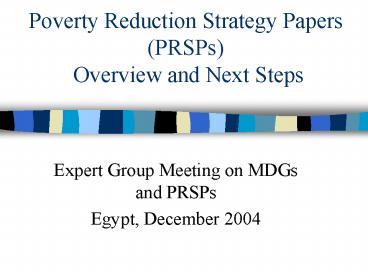Poverty Reduction Strategy Papers (PRSPs) Overview and Next Steps - PowerPoint PPT Presentation
1 / 15
Title:
Poverty Reduction Strategy Papers (PRSPs) Overview and Next Steps
Description:
Title: PowerPoint Presentation Author: Filippo Cavassini Last modified by: Filippo Cavassini Created Date: 4/19/2004 4:29:12 PM Document presentation format – PowerPoint PPT presentation
Number of Views:111
Avg rating:3.0/5.0
Title: Poverty Reduction Strategy Papers (PRSPs) Overview and Next Steps
1
Poverty Reduction Strategy Papers (PRSPs)
Overview and Next Steps
- Expert Group Meeting on MDGs and PRSPs
- Egypt, December 2004
2
Presentation outline
- PRSP Fundamentals
- Evaluating and Assessing the PRSP Process
- The Way Ahead
3
1. PRSP Fundamentals
Some milestones
OECD/DAC Shaping the 21st Century IDGs May 1996
The WB and the IMF launch the HIPC
Initiative Sept. 1996
The WB introduces the CDF, piloted in 13
countries Jan. 1999
The WB and the IMF enhance the HIPC initiative to
strengthen focus on poverty reduction Sept. 1999
The WB and the IMF introduce the PRSP Sept. 1999
UN Millennium Summit adopts MDGs Sept. 2000
4
The principles underpinning the PRSP-The
Comprehensive Development Framework
- Long-term Vision
- -short-term and medium-term policies integrated
into a national development strategy linked to a
long-term vision - Country Ownership
- -national institutions and stakeholders identify
priorities and objectives of the strategy with
technical support of development assistance
agencies - Country-led Partnership
- -coordination, alignment and harmonization of
development assistance under government
leadership - Focus on Results
- -continuous evaluation of performance to review
and update policies and programs
5
The mechanics of the PRSP
Review
Formulation
Implementation
Annual Progress Reports
Full PRSP
I-PRSP
1 year
3 years
6
As of December 2004 56 countries are
participating in the PRSP process
- 13 countries with an I-PRSP only
- 43 countries with a full PRSP
- - 3 countries (Burkina Faso, Uganda, Tanzania)
have completed three progress reports - - 4 countries (Mauritania, Mozambique,
Nicaragua, Albania) have completed two progress
reports - - 14 countries (Azerbaijan, Ghana, Honduras,
Ethiopia, Guyana, Malawi, Rwanda, Vietnam,
Zambia, Kyrgyz Republic, Mali, Tajikistan,
Guinea, Niger) have completed a progress report
beyond the 42 HIPC eligible countries!
7
The World Bank supports the PRSP through Poverty
Reduction Support Credits (PRSCs) in 22 countries
- First PRSC launched in 2001 (Uganda) and
replacing Structural Adjustment Operations - Addressing not only macroeconomic framework but
also social agenda - PRSC supporting a comprehensive reform program
linked to the PRSP - Multi-partner budget initiatives encourage
external partners to coalesce around a common
policy matrix, including the World Bank, other
MDBs and multilaterals, and bilaterals (e.g.
Uganda, Tanzania, Mozambique)
8
2. Evaluating and Assessing the PRSP Process
- 2004 OED independent evaluation of the World
Banks support to the PRSP process - - 10 country case studies 4 jointly with IMF
IEO - (Albania, Cambodia, Ethiopia, Guinea,
Mauritania, Mozambique, Nicaragua, Tajikistan,
Tanzania, Vietnam) with stakeholder surveys - 2004 World Bank and IMF Staffs assessment of
progress in implementation of PRSPs - - building on 2000, 2001, 2002 and 2003 reviews
and assessments - 2003 World Bank CDF Progress Report
- - building on 2001 assessment of CDF principles
implementation - - 48 countries with I-PRSP and PRSP
and many others undertaken outside the World
Bank and IMF (e.g. SPA/ODI, UNDP Evaluation
Office, Oxfam)
9
Main Findings
Long-term vision
- Integration of sector programs in an overall
strategy helped policymakers to link sector
strategies with poverty reduction
- Progress in setting policy priorities for
reducing poverty
- PRSP helping countries to focus on a medium-term
prospective - Insufficient links between long-term and
medium-term
10
Main Findings (cont.)
Country ownership
- WB/IMF conditionality
- Limited stakeholders involvement in
implementation - No mechanism to adapt PRSPs to differing country
conditions
- Deeper involvement of central and local
governments - PRSP not yet aligned with country processes
- Mechanisms for sustained dialogue between
government and country stakeholders rarely in
place - Political cycles often affecting PRSPs
11
Main Findings (cont.)
Country-led partnership
- External partners have not yet defined how
program content will change (but new instruments
in place) - Limited prioritization of PRSPs makes alignment
difficult to monitor
- PRSP not yet become a common framework for
aligning development assistance
- New instruments better supporting country
structures - Alignment made difficult by limited
prioritization - Capacity building not yet fully coherent
SWAps, multi-partner budget support, joint
analytical work
12
Main Findings (cont.)
Focus on results
- ME systems at an early stage
- Information not generally linked to
decision-making
- ME systems relying on poor data and indicators
- Limited institutional arrangements for monitoring
- Insufficient alignment of external and internal
ME
- External partners often supporting disparate
initiatives for ME - Excessive number of indicators
- Limited role of Parliaments in monitoring and
reviewing progress
13
3. The Way Ahead
- Aligning the PRSP with country decision-making
processes - -PRSP strengthening rather than replacing
existing national planning instruments (e.g.
Uganda, Vietnam, Mozambique, Yemen) - -Putting the PRSP more on the agenda of
established or emerging mechanisms for
sustainable dialogue - -Annual Progress Report to be aligned with
country processes (e.g. Mozambique) - -JSA becoming an advisory tool
14
The Way Ahead (cont.)
- Enhancing the role of the PRSP as a partnership
framework guiding alignment and harmonization of
external assistance - -National authorities use the PRSP as the
instrument to lead development assistance
coordination (budget support, investment projects
through SWAps) - -External partners support capacity building in
line with the PRSP
15
The Way Ahead (cont.)
- ME systems respond to country needs
- -Internal and external ME systems are
streamlined and inform the countrys
decision-making process - -External partners align support around one
country system































